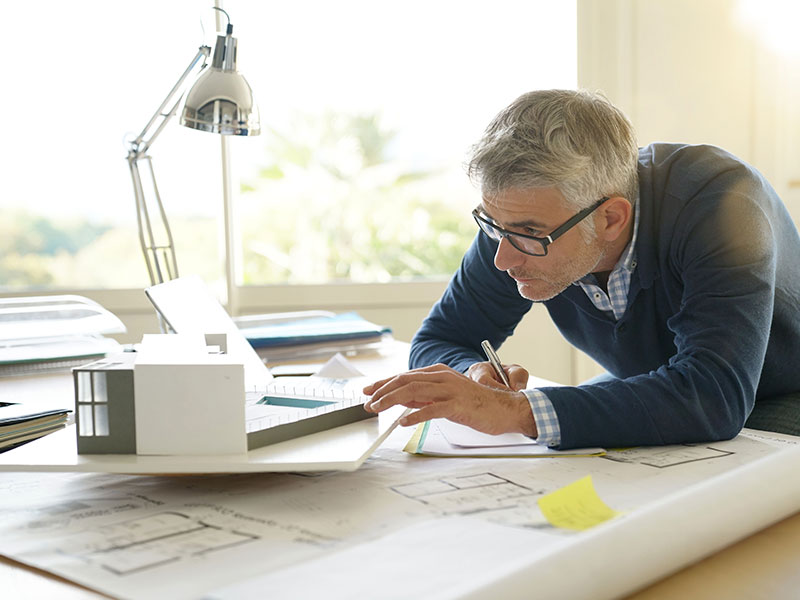Architect Firm Identity Strategies That Actually Work
Wiki Article
Recognizing the Diverse Profession Paths Available for Aspiring Architect
As a hopeful Architect, you have a globe of profession courses waiting for you. Each course supplies special challenges and possibilities to use your creative thinking and technological knowledge. Whether you're drawn to conventional style or the subtleties of lasting design, there's a niche that straightens with your passions. Comprehending these diverse options can form your specialist journey, however which direction will you choose to explore initially?Traditional Style: Designing Structures and Frameworks
Traditional style concentrates on developing buildings and structures that mix capability with aesthetic appeal. As you explore this area, you'll appreciate the elaborate balance in between type and purpose. You'll discover to attract ideas from historic designs, incorporating aspects like proportion, products, and workmanship. Your styles can mirror social heritage, showcasing local traditions while satisfying modern needs.You'll create abilities in preparing, model-making, and site analysis, permitting you to envision and connect your ideas efficiently. Engaging with customers, you'll require to recognize their vision and convert it right into feasible designs.
In addition, developing codes and sustainability techniques are crucial in your job, guaranteeing your structures are environmentally friendly and safe. As you expand in your profession, you'll find chances in domestic, commercial, or perhaps repair jobs, each offering distinct obstacles. Accepting traditional design leads the way for a meeting occupation that pays tribute to the past while forming the future.
Urban Planning: Forming Neighborhoods and Public Spaces
As an aspiring Architect, you can play a crucial function as a city organizer, transforming exactly how communities function and engage. By utilizing community engagement techniques, you'll assure that locals have a voice fit their setting. Plus, incorporating lasting style principles will help produce areas that not only fulfill today's requirements but likewise shield the future.Role of Urban Planners
While numerous might think of architects as the single visionaries behind structures, metropolitan organizers play a necessary duty in shaping the broader landscape of areas and public rooms. By collaborating with numerous stakeholders, you'll aid make parks, transportation systems, and domestic locations that promote social communication and accessibility. Your proficiency in spatial design and neighborhood dynamics enables you to imagine future growth while maintaining cultural heritage.Area Involvement Strategies
Reliable neighborhood interaction approaches are vital for urban planners to ensure that the voices of locals are listened to and valued in the preparation procedure. To foster purposeful dialogue, you should focus on open discussion forums and workshops where neighborhood participants can reveal their ideas and worries. Use surveys and social networks to reach a more comprehensive target market, guaranteeing varied point of views are consisted of. Working together with neighborhood companies can boost trust fund and help with much deeper connections. It's vital to offer clear details regarding decision-making procedures and proposed jobs, allowing citizens to feel enlightened and empowered. By actively including and listening responses, you'll create areas that mirror the area's requirements, inevitably resulting in even more sustainable and successful city settings. Embrace openness and continuous dialogue for long-term influence.Lasting Layout Principles
When developing metropolitan rooms, incorporating lasting style principles is critical for creating settings that thrive both ecologically and socially. You should start by concentrating on power efficiency, using materials that lower waste and advertise recycling. Think about incorporating green rooms, like parks and yards, to enhance biodiversity and boost air quality. Promoting walkability and public transportation can lessen reliance on automobiles, cultivating a much healthier neighborhood.Designing with water conservation in mind is additionally crucial-- consider rainfall gardens and absorptive surfaces to take care of stormwater. Involving neighborhood members throughout the planning process guarantees that the spaces you produce meet their needs and encourage social communication. By welcoming these principles, you'll contribute to vivid, lasting urban landscapes that benefit every person.

Landscape Design: Developing Lasting Outside Atmospheres
As you discover landscape design, you'll find necessary layout concepts that develop attractive and practical exterior spaces. Lasting methods play an important duty in ensuring these settings flourish while minimizing ecological influence. And also, you'll find a selection of profession opportunities that enable you to make a real distinction in exactly how individuals communicate with nature.Layout Principles in Landscape
Understanding style concepts in landscape design is essential for producing lasting exterior environments that integrate with nature. You'll need to consider aspects like balance, range, and proportion to guarantee your layouts feel cohesive and inviting. Integrating indigenous plants not just enhances biodiversity however additionally reduces water usage, making your landscape durable. Consider the flow of area and just how individuals communicate with it; pathways and seating locations must invite expedition and leisure. Additionally, take note of seasonal changes, developing with products that complement the environments year-round (Architect). anonymous By focusing on sustainability and looks, you can create outdoor rooms that enrich the neighborhood and promote well-being. Embracing these principles will establish a strong structure for your job in landscape style.Lasting Practices Overview
Lasting practices in landscape design not just concentrate on aesthetics but likewise prioritize eco-friendly wellness and source conservation. You can create areas that advertise dirt wellness, such as practicing and utilizing natural materials permaculture principles. Inevitably, these practices ensure your layouts benefit both people and the setting for years to come.Job Opportunities Exploration
With a solid foundation in lasting methods, landscape architecture supplies a range of career courses that enable you to make a significant influence on the environment. Urban organizers typically work together with landscape engineers to produce environment-friendly rooms in urban settings, improving city livability. If you're enthusiastic about education, think about other ending up being a landscape design instructor, motivating future generations.Lasting Design: Concentrating On Eco-Friendly Practices
As you explore your job in design, accepting eco-friendly practices can establish you apart in an affordable field. Lasting style focuses on creating buildings that decrease ecological impact while boosting resident health. By including renewable materials, energy-efficient systems, and lasting structure methods, you'll add to a greener future.Beginning by obtaining knowledge of eco-friendly accreditations like LEED or BREEAM, which can strengthen your credentials. Think about just how natural light, ventilation, and thermal performance can enhance layout. Work together with engineers and environmental consultants to introduce services that minimize waste and conserve resources.
Do not forget the value of neighborhood participation-- engaging local stakeholders can inspire styles that balance with the atmosphere. As clients progressively focus on sustainability, your knowledge in eco-friendly methods will certainly not just attract projects but also accomplish your enthusiasm for liable style. Welcome this important aspect of the occupation, and view your occupation grow.
Historic Conservation: Securing and Bring Back Social Heritage
While you commence on your architectural journey, take into consideration the essential duty of historic preservation in keeping our social heritage. This field concentrates on the protection and reconstruction of substantial buildings, websites, and structures that tell the stories of our past. By participating in historic preservation, you'll assist secure the architectural heritage that forms neighborhood identity.As a historical conservation Architect, you'll analyze historic importance and analyze the condition of frameworks. You'll work carefully with guardians and historians to assure authentic repair methods are used. This profession course enables you to mix creativity with study, allowing you to develop remedies that value original materials and craftsmanship.
Your job not just contributes to sustainability by reusing existing buildings but additionally promotes a feeling of satisfaction within areas. Accepting this path will help you end up click for source being a guardian of history, maintaining the stories and aesthetics that enhance our lives.
Interior Design: Enhancing Indoor Spaces
Historic preservation and indoor style both share a commitment to boosting the built environment, however they focus on different facets. While historical preservation emphasizes preserving a framework's historical and social worth, interior architecture absolutely nos in on enhancing interior rooms for capability and aesthetics.As an aspiring Architect, you'll discover that interior design enables you to blend imagination with technical abilities. You'll develop spaces that not just look excellent yet additionally advertise convenience and performance. This area involves recognizing exactly how light, shade, and products communicate within an area, influencing mood and functionality.
You'll function on different tasks, from property homes to industrial workplaces, ensuring that each environment meets the needs of its occupants. By focusing on customer experience, you can transform insides into motivating and functional areas, making a considerable effect on just how individuals connect with their environments. Accept the opportunity to boost indoor settings and shape the means individuals work and live.
Industrial Layout: Combining Functionality With Appearances
Commercial design plays an important duty in producing items that effortlessly blend visual appeals with capability, ensuring that what you use everyday is not just aesthetically enticing however also practical. As an aspiring Architect, you might involve on your own in this field, concentrating on making everything from furniture to consumer electronic devices. Your work entails understanding individual requirements, materials, and producing procedures, enabling you to create cutting-edge remedies that enhance daily experiences.In commercial style, you'll frequently work together with manufacturers, marketers, and engineers, ensuring that your styles are not only stunning yet likewise viable. This occupation course offers a vibrant setting where imagination meets usefulness, making it a fulfilling choice for designers interested in shaping the items of tomorrow.
Often Asked Inquiries
What Educational Qualifications Do I Need to Become an Architect?
To end up being an engineer, you'll require an expert degree in style, normally a Bachelor's or Master's. Furthermore, you'll need to finish an internship and pass the Architect Enrollment Evaluation to practice lawfully.Exist Certification Needs for Different Architectural Career Paths?
Yes, there're qualification needs for numerous architectural paths. Architect. You'll require to pass exams, total internships, and often go after specialized training, depending on your selected emphasis, like landscape design, urban layout, or historical preservationWhat Software Skills Are Vital for Engineers Today?

Exactly How Can I Gain Practical Experience While Studying Design?
You can obtain functional experience by interning at architectural firms, participating in layout competitors, volunteering for area projects, or collaborating with classmates on real-world assignments. These opportunities improve your skills and construct useful connections in the market.What Work Opportunities Exist Outside Standard Style Firms?
You can check out various job chances outside standard architecture companies, like urban preparation, interior decoration, landscape design, building and construction management, property advancement, and even roles in sustainability consulting. Each deals special difficulties and rewards.Whether you're drawn to typical design or the subtleties of sustainable design, there's a specific niche that straightens with your rate of interests.When designing metropolitan rooms, incorporating lasting style principles is essential for producing atmospheres that thrive both environmentally and socially.As you discover landscape design, you'll find important design concepts that create gorgeous and practical exterior areas.Comprehending layout concepts in landscape design is vital for developing lasting exterior atmospheres that harmonize with nature.In commercial design, you'll commonly work together with marketing professionals, makers, and designers, ensuring that your designs are not only beautiful yet likewise possible.
Report this wiki page